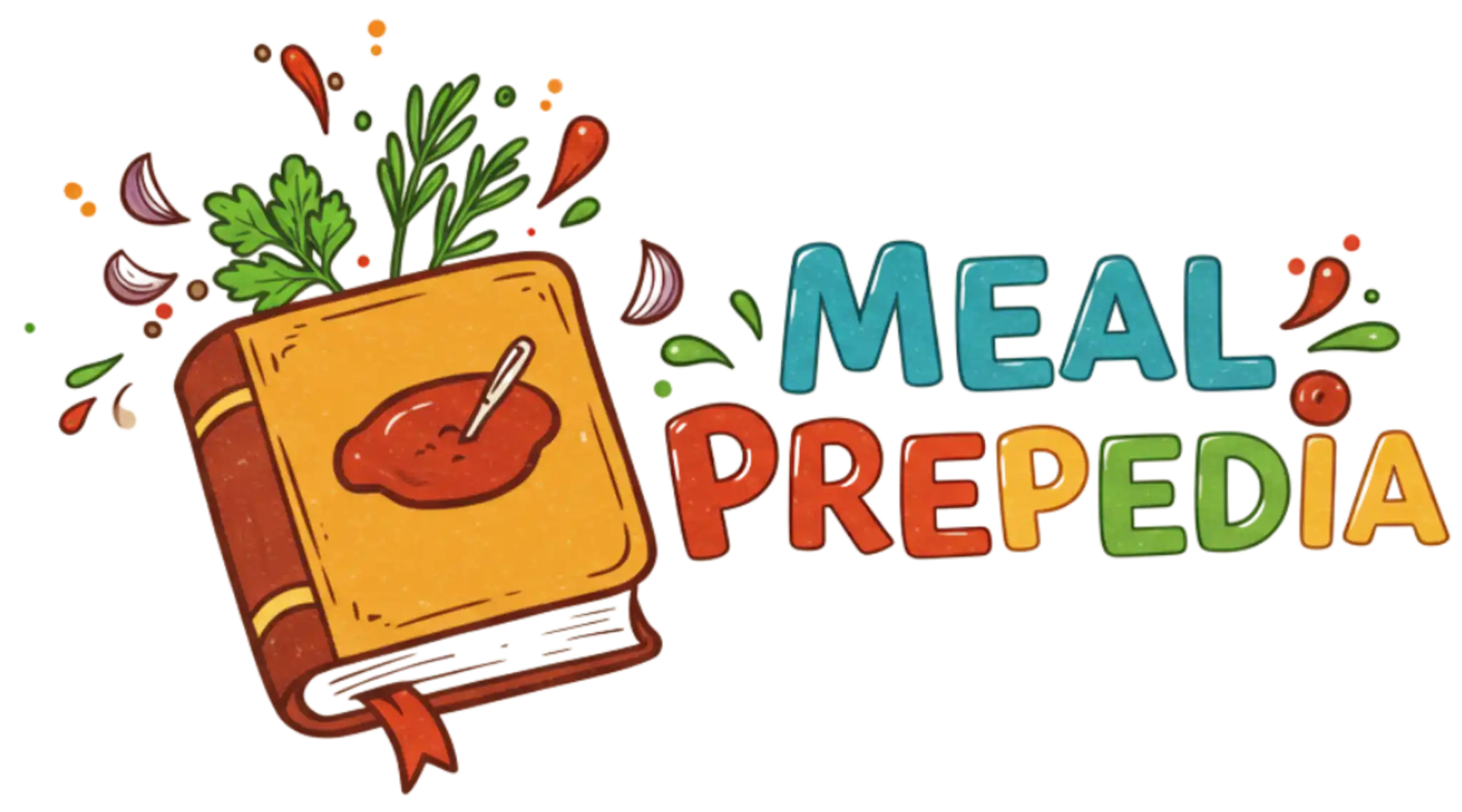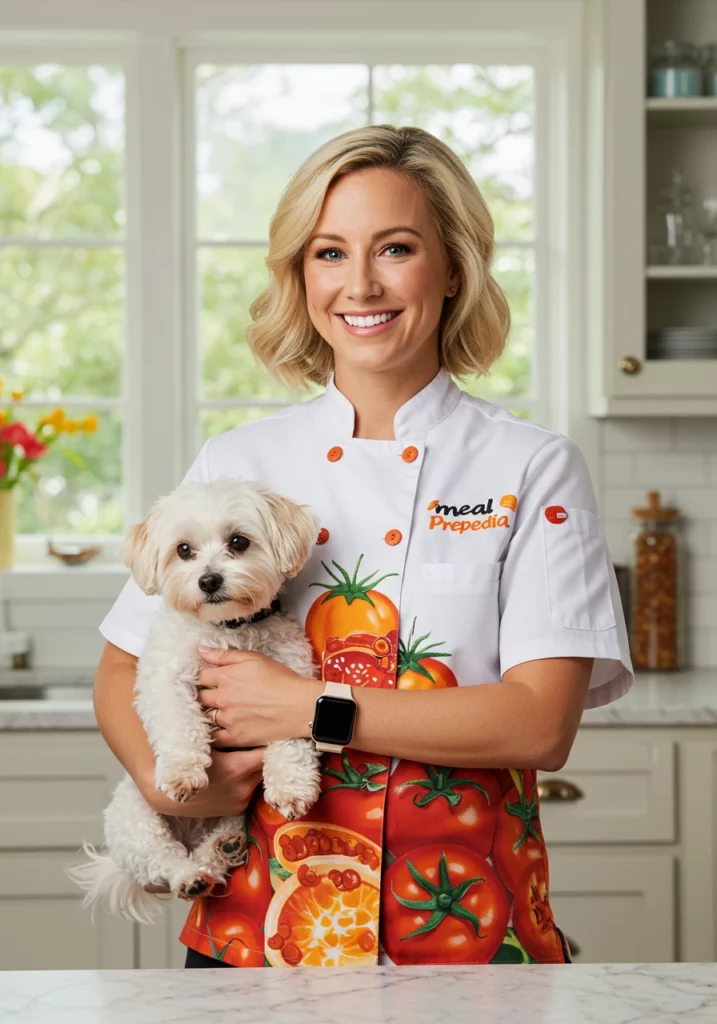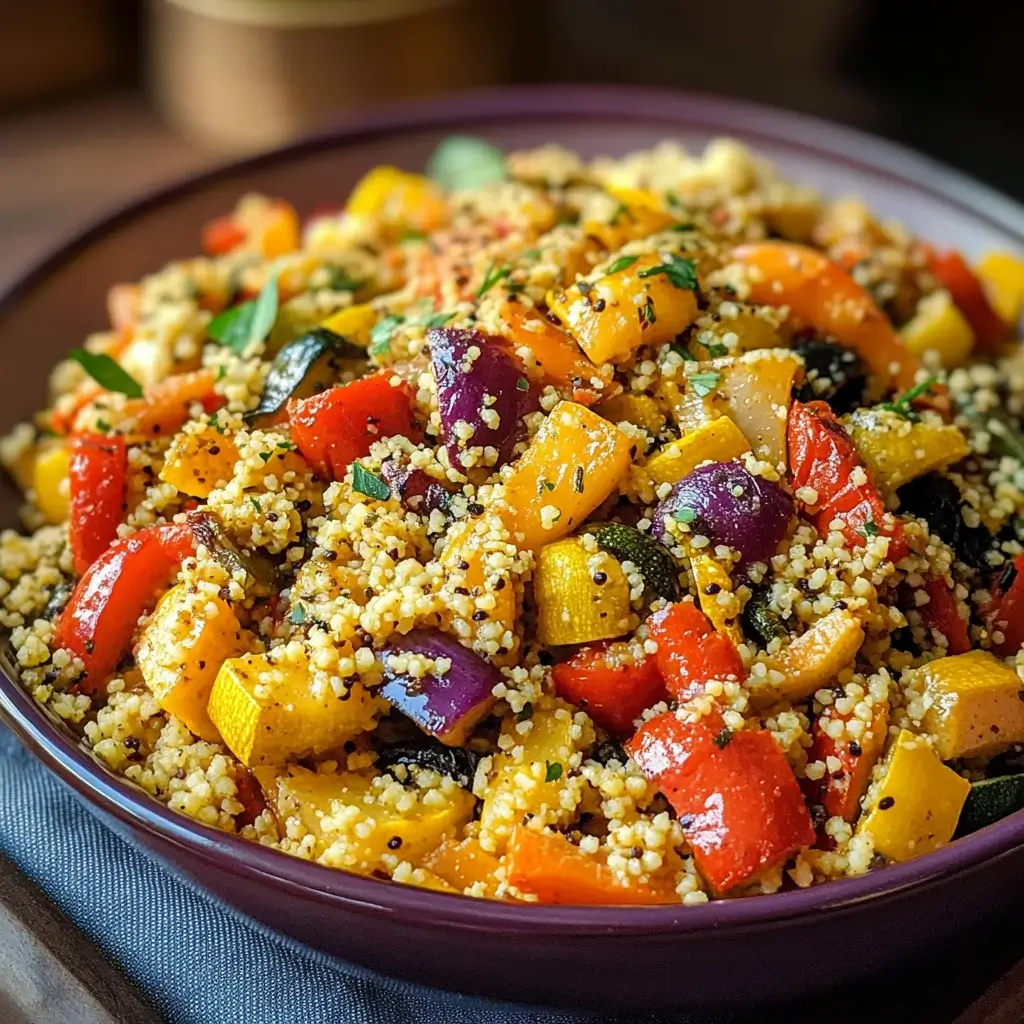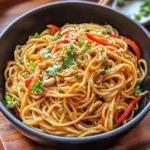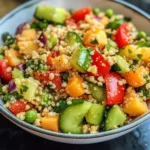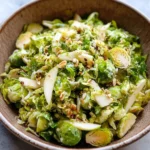This Roasted Vegetable Couscous has become an absolute staple in our household, a vibrant dish that somehow manages to feel both incredibly wholesome and delightfully indulgent. I first threw it together on a chaotic Tuesday night, needing something quick, healthy, and appealing enough to tempt even the pickiest eaters at the table (you know who you are!). The aroma wafting from the oven as the vegetables caramelized was intoxicating, promising something truly special. When I finally tossed the colourful, tender roasted veggies with the fluffy, warm couscous and a sprinkle of feta, the result was magic. It was colourful, packed with flavour, and surprisingly filling. Everyone cleaned their plates, and requests for “that veggie couscous thing” have been frequent ever since. It’s become my go-to for meal prep lunches, a reliable side dish for gatherings, and sometimes, just a simple, satisfying dinner that makes me feel good from the inside out. Its versatility and straightforward preparation make it a winner every single time, proving that healthy eating can be incredibly delicious and utterly uncomplicated.
Ingredients
Here’s what you’ll need to create this flavourful Roasted Vegetable Couscous:
- 1 large Red Bell Pepper: Adds sweetness and vibrant colour; choose a firm pepper with smooth skin.
- 1 large Yellow or Orange Bell Pepper: Provides another layer of sweetness and visual appeal.
- 1 medium Zucchini: Contributes moisture and a tender bite; look for smaller to medium-sized zucchini for better flavour and fewer seeds.
- 1 medium Red Onion: Offers a pungent sweetness that mellows beautifully when roasted; cut into wedges or thick slices.
- 1 cup Cherry or Grape Tomatoes: Bursting with juicy sweetness, they add little pockets of flavour; leave them whole.
- 1 small Eggplant (optional, approx. 1 cup cubed): Adds a creamy texture and absorbs flavours well; ensure it’s cubed similarly to other vegetables.
- 1 medium Sweet Potato (optional, approx. 1 cup cubed): Brings earthy sweetness and makes the dish heartier; peel and cube into ½-inch pieces for even roasting.
- 3 tablespoons Olive Oil: Extra virgin recommended for flavour; used to coat vegetables for roasting and prevent sticking.
- 1 teaspoon Dried Oregano: Adds a classic Mediterranean herbaceous note.
- 1 teaspoon Dried Thyme: Provides an earthy, slightly floral aroma.
- ½ teaspoon Smoked Paprika (optional): Lends a subtle smoky depth.
- Salt: To taste (approx. ¾ – 1 teaspoon for vegetables); enhances all the flavours.
- Black Pepper: Freshly ground preferred, to taste (approx. ½ teaspoon for vegetables).
- 1 ½ cups Vegetable Broth (or Chicken Broth): Used to cook the couscous, infusing it with much more flavour than water.
- 1 cup Couscous (regular Moroccan style): The quick-cooking pasta base for the dish; whole wheat can also be used for extra fibre.
- 2 tablespoons Lemon Juice: Freshly squeezed is best; adds brightness to cut through the richness.
- ¼ cup Fresh Parsley, chopped: For a burst of freshness and colour at the end.
- ¼ cup Feta Cheese, crumbled (optional): Adds a salty, tangy counterpoint; omit for vegan.
- 2 cloves Garlic, minced (optional): Can be added to the vegetables in the last 10 minutes of roasting or sautéed lightly before adding couscous liquid.
Instructions
Follow these steps to create your delicious Roasted Vegetable Couscous:
- Preheat and Prep: Preheat your oven to 400°F (200°C). Line a large baking sheet (or two if necessary to avoid overcrowding) with parchment paper for easy cleanup.
- Chop the Vegetables: Wash and chop the bell peppers, zucchini, red onion, and eggplant (if using) into bite-sized pieces, aiming for roughly 1-inch chunks. Keep the cherry tomatoes whole. If using sweet potato, peel and cube it into slightly smaller ½-inch pieces as it takes longer to cook. Consistency in size helps ensure even roasting.
- Season the Vegetables: Place all the chopped vegetables (except the tomatoes and minced garlic, if using later) onto the prepared baking sheet(s). Drizzle generously with the olive oil. Sprinkle evenly with dried oregano, dried thyme, smoked paprika (if using), salt, and freshly ground black pepper. Use your hands or a large spoon to toss everything together, making sure each piece is lightly coated with oil and seasonings.
- Arrange for Roasting: Spread the vegetables in a single layer on the baking sheet(s). It’s crucial not to overcrowd the pan, as this will cause the vegetables to steam rather than roast and caramelize. If needed, use a second baking sheet.
- Roast the Vegetables: Place the baking sheet(s) in the preheated oven. Roast for 25-35 minutes. About halfway through the roasting time (around 15 minutes), add the cherry tomatoes to the pan (and minced garlic, if adding now). Give everything a gentle stir or shake the pan to promote even cooking. Continue roasting until the vegetables are tender, slightly charred at the edges, and beautifully caramelized. The sweet potato should be easily pierced with a fork.
- Cook the Couscous: While the vegetables are roasting, prepare the couscous. Bring the vegetable broth to a boil in a medium saucepan. Once boiling, remove the saucepan from the heat. Stir in the couscous. Cover the saucepan tightly with a lid and let it stand for 5-7 minutes, or according to your package directions, until all the liquid has been absorbed.
- Fluff the Couscous: After the standing time, remove the lid and fluff the couscous gently with a fork. This separates the grains and makes it light and airy.
- Combine and Finish: Once the vegetables are perfectly roasted, remove them from the oven. Transfer the fluffed couscous to a large serving bowl. Add the roasted vegetables directly to the bowl with the couscous.
- Add Final Flavours: Drizzle the fresh lemon juice over the couscous and vegetables. Add the chopped fresh parsley. If using, sprinkle the crumbled feta cheese over the top.
- Toss and Serve: Gently toss everything together until well combined, being careful not to mash the tender vegetables. Taste and adjust seasoning if necessary, adding more salt, pepper, or lemon juice according to your preference. Serve the Roasted Vegetable Couscous warm or at room temperature.
Nutrition Facts
This information is an estimate and can vary based on specific ingredients and portion sizes.
- Servings: This recipe typically yields 4-6 servings as a main course, or 6-8 servings as a side dish.
- Calories per Serving (approximate): Around 350-450 calories per main course serving (assuming 4 servings).
- Fibre: High in dietary fibre due to the abundance of vegetables and potentially whole wheat couscous. Fibre aids digestion and promotes satiety, keeping you feeling full longer.
- Vitamins & Minerals: Rich in various vitamins and minerals from the colourful vegetables, particularly Vitamin C (from bell peppers and tomatoes), Vitamin A (if using sweet potato), and potassium.
- Healthy Fats: Primarily contains monounsaturated fats from olive oil, which are beneficial for heart health. The amount will vary based on the oil used.
- Plant-Based Protein: Provides a moderate amount of plant-based protein, especially if chickpeas or nuts are added or whole wheat couscous is used. Feta cheese also contributes some protein.
Preparation Time
- Preparation Time: Approximately 15-20 minutes (for washing and chopping vegetables).
- Cooking Time: Approximately 30-40 minutes (25-35 minutes for roasting vegetables, 5-10 minutes for couscous preparation including standing time).
- Total Time: Approximately 45-60 minutes from start to finish. This makes it a fantastic option for a relatively quick weeknight meal or efficient meal prepping.
How to Serve
Roasted Vegetable Couscous is wonderfully versatile. Here are several ways to serve it:
- As a Standalone Vegetarian/Vegan Main Course:
- Serve warm in bowls for a comforting and complete meal.
- It’s naturally vegetarian, and easily made vegan by omitting the feta cheese (or using a vegan substitute).
- As a Flavourful Side Dish:
- Pair it alongside grilled chicken breasts or thighs.
- Serve with baked or grilled fish like salmon or cod.
- Excellent accompaniment to lamb koftas or kebabs.
- Complements grilled halloumi cheese beautifully.
- Enhanced with Toppings and Add-ins:
- Cheese: Besides feta, try crumbled goat cheese for tangy creaminess.
- Nuts and Seeds: Add a delightful crunch with toasted pine nuts, slivered almonds, pumpkin seeds (pepitas), or sunflower seeds.
- Fresh Herbs: Boost the freshness with chopped fresh mint or cilantro in addition to or instead of parsley.
- Legumes: Stir in a can of drained and rinsed chickpeas or lentils for extra protein and fibre.
- Dressing: Drizzle with a light lemon vinaigrette, tahini dressing, or a balsamic glaze for extra flavour dimensions.
- Yogurt/Tzatziki: A dollop of plain Greek yogurt or cool tzatziki sauce on top provides a creamy contrast.
- For Meal Prep and Potlucks:
- Perfect for packing into lunch containers for the week. It tastes great cold or reheated gently.
- Ideal for bringing to potlucks or picnics as it holds up well and is delicious at room temperature.
- Presentation:
- Serve in a large, shallow bowl family-style to showcase the vibrant colours.
- Plate individually, perhaps moulding the couscous slightly and arranging the vegetables attractively. Garnish generously.
Additional Tips
Enhance your Roasted Vegetable Couscous experience with these eight tips:
- Maximize Vegetable Flavour: Don’t be afraid to let the vegetables get deeply roasted with some charred edges. This caramelization process develops intense sweetness and complexity that is key to the dish’s flavour profile. Use high enough heat (400°F/200°C or even 425°F/220°C) and give them enough time.
- Spice It Up: Tailor the spices to your preference. Consider adding ½ teaspoon of cumin for earthiness, a pinch of red pepper flakes for heat, or even a teaspoon of za’atar spice blend for a Middle Eastern flair. Experimenting with spices keeps the recipe exciting.
- Use Pearl (Israeli) Couscous: For a different texture, try using pearl (Israeli) couscous. It consists of larger pasta pearls with a chewier bite. Note that it requires a slightly different cooking method (usually simmering like pasta or risotto) and takes longer to cook (around 10-15 minutes), so adjust accordingly.
- Infuse the Couscous: Beyond using broth, add extra flavour to the couscous itself. Sauté the minced garlic or some finely chopped shallots in a little olive oil in the saucepan before adding the broth and bringing it to a boil. You could also stir in a knob of butter or a drizzle of olive oil along with the couscous for richness. A bay leaf added to the boiling broth also imparts subtle flavour.
- Incorporate Greens: For an extra nutritional boost and colour contrast, stir in a few handfuls of baby spinach or arugula into the warm couscous right after fluffing it. The residual heat will wilt the greens perfectly without needing extra cooking.
- Strategic Roasting: If using denser vegetables like sweet potatoes or butternut squash alongside quicker-cooking ones like zucchini and bell peppers, give the denser vegetables a head start. Add them to the oven 10-15 minutes before adding the softer vegetables to ensure everything becomes tender simultaneously.
- Brighten with Citrus Zest: Before juicing the lemon, zest it! Adding a teaspoon or two of lemon zest along with the juice intensifies the bright citrus flavour without making it overly tart. It adds a wonderful aromatic quality.
- Plan for Leftovers (They’re Great!): This dish is fantastic for meal prep. Store leftovers in an airtight container in the refrigerator for up to 3-4 days. It’s delicious cold, at room temperature, or gently reheated. If it seems a bit dry upon reheating, add a splash of broth or a squeeze of lemon juice. Consider storing components separately (veggies, couscous) if you prefer to reheat only the vegetables.
Frequently Asked Questions (FAQ)
Q1: Can I use frozen vegetables for this recipe?
A1: While fresh vegetables yield the best texture and flavour through roasting, you can use frozen vegetables in a pinch. Do not thaw them first. Spread them directly onto the baking sheet, toss with oil and seasonings, and roast at a slightly higher temperature (around 425°F/220°C). They may release more water, so avoid overcrowding the pan even more diligently. Roasting time might need adjustment. The final texture might be softer than with fresh vegetables.
Q2: Is this Roasted Vegetable Couscous recipe gluten-free?
A2: No, traditional couscous is made from semolina wheat and contains gluten. To make this recipe gluten-free, substitute the couscous with a naturally gluten-free grain like quinoa, brown rice, millet, or certified gluten-free oats. You could also use cauliflower rice for a low-carb option. Adjust cooking times and liquid ratios according to the grain you choose.
Q3: How can I make this dish higher in protein?
A3: There are several easy ways! Stir in a can of drained and rinsed chickpeas or lentils along with the roasted vegetables. Add grilled or shredded chicken, cooked shrimp, crumbled cooked sausage, or pan-fried halloumi cheese. Topping with toasted nuts and seeds (like almonds, walnuts, pumpkin seeds) also adds a protein boost. Using whole wheat couscous offers slightly more protein than regular.
Q4: My vegetables didn’t brown properly, they just got soft. What did I do wrong?
A4: This usually happens for a few reasons:
Overcrowding: The most common culprit. If vegetables are packed too tightly, they steam instead of roast. Use multiple baking sheets if necessary.
Oven Temperature Too Low: Ensure your oven is fully preheated to at least 400°F (200°C). Roasting requires high heat for caramelization.
Too Much Moisture: Make sure vegetables are dried reasonably well after washing. Excess water hinders browning.
Not Enough Oil: A light coating of oil helps conduct heat and promotes crisping and browning.
Q5: Can I prepare parts of this recipe ahead of time?
A5: Absolutely! To save time on busy nights:
Chop Vegetables: Wash and chop the vegetables up to 2-3 days in advance and store them in an airtight container in the refrigerator.
Roast Vegetables: Roast the vegetables completely, let them cool, and store them in the fridge for up to 3 days. Reheat gently or add cold to the couscous.
Cook Couscous: Cook the couscous, fluff it, let it cool, and store it separately in the fridge for up to 3 days.
Combine just before serving or eat components mixed and cold/reheated.
Q6: What other vegetables work well in this recipe?
A6: This recipe is incredibly adaptable! Try adding or substituting with:
Broccoli florets
Cauliflower florets
Brussels sprouts (halved)
Butternut squash cubes
Carrots (sliced or diced)
Asparagus spears (add in the last 10-15 minutes of roasting)
Mushrooms (quartered or sliced)
Green beans (trimmed)
Remember to adjust roasting times based on the density of the vegetables used.
Q7: Can I use water instead of broth to cook the couscous?
A7: You can, but using vegetable or chicken broth adds significantly more depth of flavour to the couscous, making the overall dish much tastier. If you only have water, consider adding a bouillon cube or powder, or increase the seasoning (salt, herbs) added to the final dish to compensate.
Q8: How do I store leftovers and for how long?
A8: Store leftover Roasted Vegetable Couscous in an airtight container in the refrigerator. It will keep well for 3 to 4 days. You can enjoy it cold straight from the fridge, let it come to room temperature, or reheat it gently in the microwave or on the stovetop. If reheating, adding a tiny splash of water or broth can help prevent it from drying out. Note that the texture of the vegetables might soften slightly upon storage and reheating.
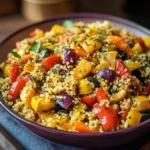
Roasted Vegetable Couscous
Ingredients
Here’s what you’ll need to create this flavourful Roasted Vegetable Couscous:
- 1 large Red Bell Pepper: Adds sweetness and vibrant colour; choose a firm pepper with smooth skin.
- 1 large Yellow or Orange Bell Pepper: Provides another layer of sweetness and visual appeal.
- 1 medium Zucchini: Contributes moisture and a tender bite; look for smaller to medium-sized zucchini for better flavour and fewer seeds.
- 1 medium Red Onion: Offers a pungent sweetness that mellows beautifully when roasted; cut into wedges or thick slices.
- 1 cup Cherry or Grape Tomatoes: Bursting with juicy sweetness, they add little pockets of flavour; leave them whole.
- 1 small Eggplant (optional, approx. 1 cup cubed): Adds a creamy texture and absorbs flavours well; ensure it’s cubed similarly to other vegetables.
- 1 medium Sweet Potato (optional, approx. 1 cup cubed): Brings earthy sweetness and makes the dish heartier; peel and cube into ½-inch pieces for even roasting.
- 3 tablespoons Olive Oil: Extra virgin recommended for flavour; used to coat vegetables for roasting and prevent sticking.
- 1 teaspoon Dried Oregano: Adds a classic Mediterranean herbaceous note.
- 1 teaspoon Dried Thyme: Provides an earthy, slightly floral aroma.
- ½ teaspoon Smoked Paprika (optional): Lends a subtle smoky depth.
- Salt: To taste (approx. ¾ – 1 teaspoon for vegetables); enhances all the flavours.
- Black Pepper: Freshly ground preferred, to taste (approx. ½ teaspoon for vegetables).
- 1 ½ cups Vegetable Broth (or Chicken Broth): Used to cook the couscous, infusing it with much more flavour than water.
- 1 cup Couscous (regular Moroccan style): The quick-cooking pasta base for the dish; whole wheat can also be used for extra fibre.
- 2 tablespoons Lemon Juice: Freshly squeezed is best; adds brightness to cut through the richness.
- ¼ cup Fresh Parsley, chopped: For a burst of freshness and colour at the end.
- ¼ cup Feta Cheese, crumbled (optional): Adds a salty, tangy counterpoint; omit for vegan.
- 2 cloves Garlic, minced (optional): Can be added to the vegetables in the last 10 minutes of roasting or sautéed lightly before adding couscous liquid.
Instructions
Follow these steps to create your delicious Roasted Vegetable Couscous:
- Preheat and Prep: Preheat your oven to 400°F (200°C). Line a large baking sheet (or two if necessary to avoid overcrowding) with parchment paper for easy cleanup.
- Chop the Vegetables: Wash and chop the bell peppers, zucchini, red onion, and eggplant (if using) into bite-sized pieces, aiming for roughly 1-inch chunks. Keep the cherry tomatoes whole. If using sweet potato, peel and cube it into slightly smaller ½-inch pieces as it takes longer to cook. Consistency in size helps ensure even roasting.
- Season the Vegetables: Place all the chopped vegetables (except the tomatoes and minced garlic, if using later) onto the prepared baking sheet(s). Drizzle generously with the olive oil. Sprinkle evenly with dried oregano, dried thyme, smoked paprika (if using), salt, and freshly ground black pepper. Use your hands or a large spoon to toss everything together, making sure each piece is lightly coated with oil and seasonings.
- Arrange for Roasting: Spread the vegetables in a single layer on the baking sheet(s). It’s crucial not to overcrowd the pan, as this will cause the vegetables to steam rather than roast and caramelize. If needed, use a second baking sheet.
- Roast the Vegetables: Place the baking sheet(s) in the preheated oven. Roast for 25-35 minutes. About halfway through the roasting time (around 15 minutes), add the cherry tomatoes to the pan (and minced garlic, if adding now). Give everything a gentle stir or shake the pan to promote even cooking. Continue roasting until the vegetables are tender, slightly charred at the edges, and beautifully caramelized. The sweet potato should be easily pierced with a fork.
- Cook the Couscous: While the vegetables are roasting, prepare the couscous. Bring the vegetable broth to a boil in a medium saucepan. Once boiling, remove the saucepan from the heat. Stir in the couscous. Cover the saucepan tightly with a lid and let it stand for 5-7 minutes, or according to your package directions, until all the liquid has been absorbed.
- Fluff the Couscous: After the standing time, remove the lid and fluff the couscous gently with a fork. This separates the grains and makes it light and airy.
- Combine and Finish: Once the vegetables are perfectly roasted, remove them from the oven. Transfer the fluffed couscous to a large serving bowl. Add the roasted vegetables directly to the bowl with the couscous.
- Add Final Flavours: Drizzle the fresh lemon juice over the couscous and vegetables. Add the chopped fresh parsley. If using, sprinkle the crumbled feta cheese over the top.
- Toss and Serve: Gently toss everything together until well combined, being careful not to mash the tender vegetables. Taste and adjust seasoning if necessary, adding more salt, pepper, or lemon juice according to your preference. Serve the Roasted Vegetable Couscous warm or at room temperature.
Nutrition
- Serving Size: one normal portion
- Calories: 450
